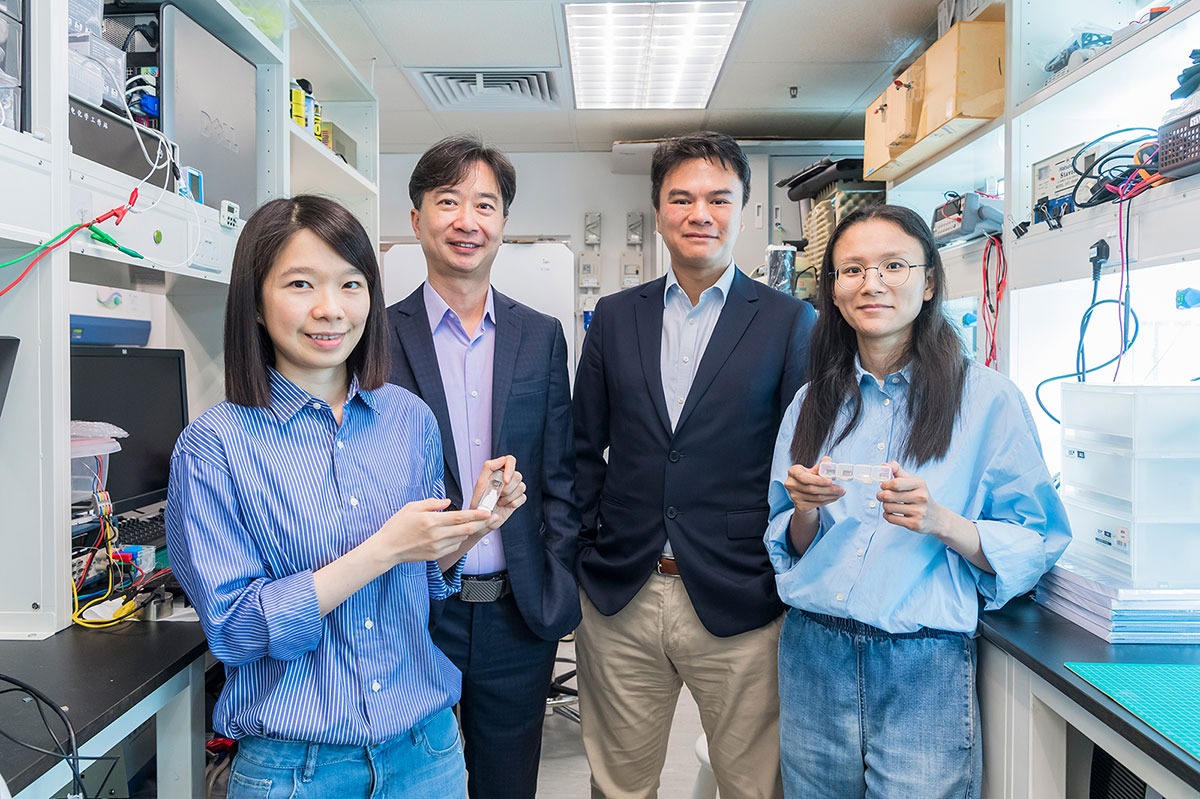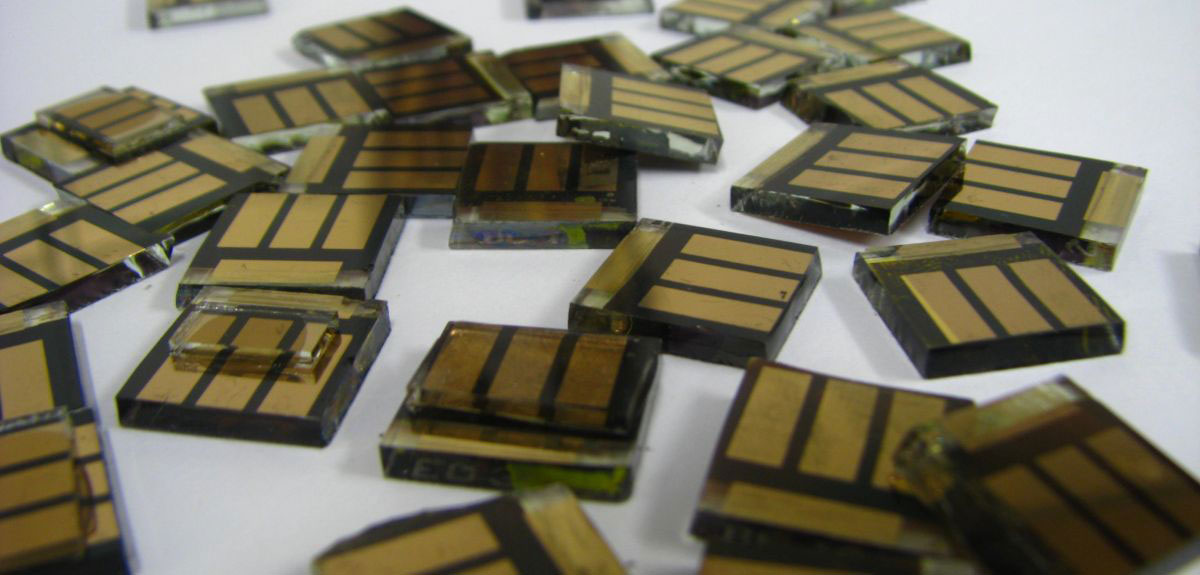Left to right: City University of Hong Kong (CityUHK) researchers Wei-Ting Wang, Shien-Ping Feng, Hin-Lap Yip and Ning Zhou. The team collaborated with researchers at the University of Oxford and other institutions on a passivation strategy to boost the stability and operating life of perovskite PVs. [Image: CityUHK]
Perovskite solar cells, which offer the potential for a new generation of cheap-to-produce, lightweight photovoltaics (PVs), have seen dramatic improvements in power conversion efficiency (PCE) in lab studies. A persistent hurdle to their commercial rollout, however, has been their comparatively low durability and stability. Outside of the lab, in actual operation, the PCE of perovskite PVs can degrade rather quickly as they confront ongoing heat, humidity and other environmental insults. That puts them at a big competitive disadvantage to the more mature and robust technology of silicon PVs.
One technique used to protect perovskite PVs from such degradation is passivation—applying a protective coating that locks down ionic defects in the material to keep environmental stressors from gaining a chemical toehold. Most passivation strategies now being used, though, heal only ionic defects created during the manufacturing process. What about additional problems that creep into the material after that, during storage or the day-to-day grind of actual operation?
A team led by researchers at the City University of Hong Kong (CityUHK), Hong Kong, and the University of Oxford, UK, has now proposed a solution: a “living passivation” strategy (Nature, doi: 10.1038/s41586-024-07705-5). The approach centers around a passivation substance with so-called dynamic covalent bonds that, when triggered by moisture and heat—the very factors that cause new defects in the perovskite lattice—release additional passivation agents to sniff out and heal the emerging wounds.
In lab tests of its living passivator on perovskite samples, the team was able to demonstrate high power-conversion efficiencies that decreased only modestly after a thousand hours or more in high heat and humidity.
In lab tests of its living passivator on perovskite samples, the team was able to demonstrate devices with PCEs greater than 25%. And those efficiency numbers decreased only modestly after a thousand hours or more in high heat and humidity.
Environmental toll on performance
As perovskite PVs do their work of converting sunlight into electricity, heat, moisture and the light itself inevitably take their toll, causing the development over time of charge-carrier barriers or traps that degrade performance. This inconvenient fact has spurred a search for strategies to passivate the perovskite surface and make it more resistant to long-term decline.
One commonly employed family of passivating substances, particularly for lead-based perovskite PVs, is so-called Lewis bases. These are essentially molecules whose orbitals are arranged in such a way that they can easily donate a pair of electrons to form a covalent bond. In work published a decade ago, the lab of Henry Snaith at Oxford showed that Lewis-base passivation could boost both photoluminescence lifetimes and efficiencies of perovskite PVs. More recent work across multiple labs has explored the use of Lewis bases among many other materials in passivation strategies for perovskites.
One problem for all such schemes, however, is that they have commonly focused on neutralizing ionic defects in the material that are already present at manufacture. That’s obviously essential—but it means that the passivation benefits are limited to specific locations in the material, and don’t extend to new defects generated during storage and operation.
Inspiration from natural healing
Perovskite solar cells. [Image: University of Oxford]
The team behind the new work, led by Snaith at Oxford and Shien-Ping Feng at CityUHK, sought a passivation strategy that could work on such late-breaking defects as they arose. In a CityUHK press release describing the research, Feng noted that such “living passivation” takes its cue from the resilience of plants and other living organisms, which, unlike perovskites, can stand up to years of abuse from wind, heat and weather. “The key difference,” said Fung, “lies in the ability of living organisms to regenerate and heal evolving defects.”
To bring such living regeneration to perovskites, the research team designed a passivator with a formidable name: a hindered urea/thiocarbamate bond Lewis acid-base material (mercifully abbreviated as HUBLA). The material’s secret sauce, born in the chemistry lab, lies in its dynamic covalent bonds. These include a hindered urea bond (HUB), which breaks in the presence of water at room temperature, and a thiocarbamate bond (TCB), which shows similar dynamic behavior at elevated temperatures.
Combining the HUB and TCB into HUBLA, the researchers write, creates a living passivator that “can be triggered by environmental factors to generate new passivators” in the form of Lewis bases. The result is a passivation treatment that, in principle, should be able to help neutralize new defects in the perovskite as they arise over time.
Making passivation dynamic
To put HUBLA to the test, the team used it as a treatment for perovskite thin films, and carefully characterized the films’ optoelectronic properties and performance in a series of experiments. In one such experiment, they aged a small area of one such passivated film by exposing it to intense light (equivalent to more than 96 suns), and compared the photoluminescence (PL) of the treated area with that of similarly aged control films without passivation.
Results of photoluminescence tests, the researchers argue, show “that HUBLA is dynamically passivating defects or traps in the photo absorber, and healing the perovskite film.”
In both cases, the PL intensity of the treated area improved, a well-known phenomenon known as photo-brightening. The passivated film, however, scored an order of magnitude higher on PL improvement—an indication, the researchers write, “that HUBLA is dynamically passivating defects or traps in the photo absorber, and healing the perovskite film.”
The team also fabricated HUBLA-passivated p-i-n perovskite devices and compared their stability with similar control devices. The researchers found that in air at 85 °C and 30% relative humidity, the control devices sagged to around 50% of their initial PCE after a mere 400 hours, while the HUBLA-passivated devices held onto 88% of their initial efficiency after 1000 hours. In dry nitrogen at 85 °C, the HUBLA devices were even more robust, retaining 94% of their initial PCE after 1500 hours.
Toward commercialization
The researchers conclude that the use of HUBLAs with dynamic covalent bonds constitutes “a real-time responsive passivation strategy” that can “passivate as-deposited perovskite films not only during the passivation process, but also afterwards.” According to a press release accompanying the research, the team is now working with industry to apply the technology to perovskites in actual manufacturing and operation. Beyond the potential to make perovskite PVs more commercially viable, the team thinks the approach could also be used “in other applications, such as anti-oxidation and interfacial contact engineering in microelectronic devices.”
In addition to personnel from CityUHK and Oxford, the research also included contributions from scientists at the Australian Research Council Centre of Excellence in Exciton Science, Australia; at Xi’an Jiaotong University, China; and at Tunghai University and National Central University, Taiwan.



